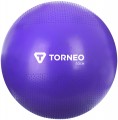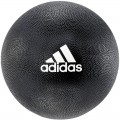Max. user weight
The maximum mass that the shell of a gymnastic ball is able to withstand. The maximum user weight is closely related to the maximum load on the inflatable bladder. In the process of jumping and swinging, a user weighing 100 kg can create almost twice as much load on the fitball, for this reason, in parallel with the weight limit, manufacturers of gymnastic balls often indicate the value of the maximum load.
Product type
—
Fitball. It is a large rubber ball, which is characterized by extremely high elasticity and high strength characteristics. It is used in many areas of physical development and medical rehabilitation, including Pilates, aerobics and fitness. Fitball is an important sports equipment in high-intensity interval training, and is also widely used during rehabilitation after illnesses and operations, the treatment and prevention of disorders in neurodevelopment. When choosing a fitball, you should pay attention to the diameter of the gymnastic ball. For a person with a height of 160-170 cm, a ball with a diameter of 65 cm is considered optimal.
—
Medball. A sports equipment that looks like a dense and heavy ball. The rubber shell of the medicine ball is stuffed with shavings, sand or a viscous gel. Due to the heavy padding, which absorbs impact force, the product almost completely stops bouncing off obstacles. The main purpose is the recovery and rehabilitation of athletes after various injuries and diseases. But there are also special models for conducting full-fledged sports training. The product allows you to create a safe load for the joints. Most often, a dense ball is used as a weighting agent. With a medicine ball, you can squat, pump the press, do lunges, etc. Additionally, a medicine ball is often used as a kettlebell or dumbbell. This projectile can be thrown to each other or bounced off the
...wall/floor. The most widely used medicine balls weighing 1-20 kg, but there are specimens weighing up to 50 kg. The diameter of the average medicine ball is 20-35 cm.
— Slamball. A dense elastic shell that is stuffed with sand or crumbs. The medicine ball is used for throws, tosses and hits on the floor/wall. Slamball allows you to train the so-called explosive strength and power, the projectile is often used in the preparation of wrestlers and MMA fighters. The closest analogue of slamball is medball. These types of medicine balls differ from each other in the level of inertia. If the medicine ball partially bounces off obstacles, then the slamball completely extinguishes the force of inertia. At the same time, the slamball has a rougher and denser shell, which allows you to put all the power into throws and strikes.
— Volball. A medicine ball designed for exercise is best suited for developing shooting power. They are great for throwing them against the wall, which, in fact, is reflected in the name (wall — wall). The key feature is the absence of springy inertia — falling to the ground, the Volball does not bounce. Outside, the balls have a soft, shapeless hardware. Models may vary in weight. Volballs weighing 3, 6 and 9 kg are widely used. The packing is usually sand or metal shavings, but many other materials can be used.Equipment
—
Anti-break (ABS) — a safety system that prevents a sharp break of the ball as a result of a puncture of the inflatable chamber. Implemented by Anti-Burst System (ABS) technology. Some manufacturers label anti-burst fitballs with the abbreviation BRQ (Burst Resistant Quality). In essence, ABS and BRQ technologies are completely identical. Anti-explosion involves the use of a dense inflatable chamber. The structure of such a ball endures even high loads, and if a puncture occurs, the inflatable chamber will not be torn by the pressure of the outgoing air — the ball will simply slowly deflate. In this case, there will not even be a deafening pop, as when a balloon is punctured.
—
Spikes provide a massage effect. Fitballs with spikes are used for relaxation, treatment and prevention of various ailments. Spikes can be both pronounced and partially pronounced.
—
Pump. The gymnastic ball is in addition completed with the pump. As a pump, a foot-operated air pump is most often used, which is connected to the inflatable chamber with an extension hose. But the pump can be manual. Typically, a manual air pump does not use a flexible extension hose.
—
Expanders are elastic extensions with a handle for a comfortable grip. The spring properties of the expander allow you to create an additional load on various muscle gr
...oups, so you can significantly expand the scope of the gymnastic ball. Most often, the fitball is equipped with a pair of expanders. For their secure fixation, lugs built into the inflatable chamber are often used, but in some cases, expanders can also use an external belt for fixation.Diameter
The diameter of the fitball largely determines the age category of users. Gymnastic balls for adults have a diameter of 50-80 cm, while for children — about 30-50 cm.
Regarding medicine balls, the diameter of the vast majority of balls is in the range of 20-35 cm. Some manufacturers of medicine balls tie the diameter to the mass. With an increase in the weight of a sports equipment, the diameter may also increase. Additionally, the girth of the medicine ball may depend on the specific purpose of the ball. Projectiles for throws, bench press and weighting during warm-up often differ from each other in diameter.
Weight
This parameter is primarily relevant for stuffed balls, which are represented by medicine balls and slamballs. It is generally accepted that the optimal mass of a stuffed ball is 10% of the athlete's weight. If the medicine ball is chosen for a person weighing 80 kg, then the optimal projectile in this case will be a stuffed ball weighing 8 kg.

